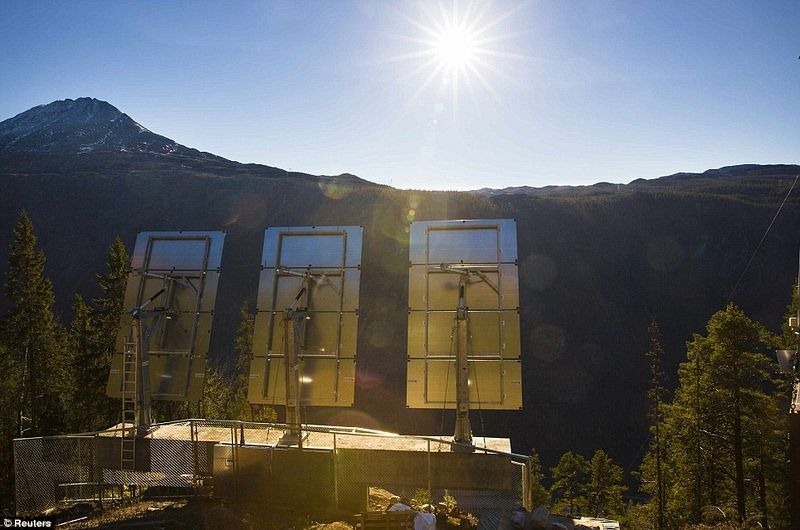Rjukan is a small industrial town in the municipality of Telemark, in Norway, that lies at the bottom of a deep valley at the foot of the mighty Gaustatoppen mountain. The steep slopes of the surrounding mountains completely block out the sun for half the year, leaving this thriving community of 3,400 in permanent shadow from September to March.
But since 2013, the town’s residents has been basking under a tiny patch of sunlight that falls right over the market square. This light is reflected from three large heliostatic mirrors called “Solspeil” installed on the mountainside about 450 meters above the town’s square. The mirrors capture the sunlight and direct it into the market square where it illuminates an area of about 600 square meters. Controlled by computers, the mirrors follow the sun’s movement across the sky, moving every 10 seconds so that Rjukan’s square remains sun drenched for the entire length of the day.
The plan to illuminate Rjukan was first drawn up 100 years ago by the town’s founder and industrialist Sam Eyde, who started a fertilizer factory there. Rjukan was chosen because it was near a 104-meter waterfall, which provided easy means of generating large quantities of electricity. It is estimated that Eyde spend about two times the national budget of Norway to build Rjukan and his factory.
But Eyde couldn’t implement his idea for the technology wasn’t there. Instead, his company paid for the construction of a gondola in 1928, which the townsfolk could use, for a small fee, to ride nearly 500 meters up the mountain and into the sunlight. This gondola is called Krossobanen and it remains functional still today transporting thousands of people to the mountains every year.
The idea to light up Rjukan was revived in 2005 by Martin Andersen, an artist and resident of the town. Andersen heard about a partially covered sports stadium in Arizona that was successfully using small mirrors to keep its grass growing. He also learned how heliostat were being used to reflect concentrated beams of sunlight to heat steam turbines to produce electricity. The following year, the Italian town Viganella successfully installed a similar sun mirror to reflect sunlight into the village. Viganella, just like Rjukan, is located in a valley where the mountains cast long shadows for three months in the winter.
Andersen persuaded the town hall to come up with the cash to allow him to develop his project further. He contacted experts in the field and also visited Viganella himself. Finally, with the help of public investment and private sponsorship, most of which came from Norsk Hydro, the company founded by Sam Eyde, Andersen raised 5 million Norwegian krone (about $851,000) that allowed the town to complete the project.

Sources: The Guardian / BBC / Wikipedia / Visit Norway



















Since technology has improved, why not installing solar panels and giant LED light? It won't cost as much as it used to.
ReplyDeleteFull spectrum lightbulbs might have full benefits of sunlight, but eventually they'll need to be replaced. With mirrors, you can simply wipe them clean and for the people, they probably get more joy of sunlight then artificial lighting.
DeleteI'm not sure what purpose the solar panels in this setup serve.
The solar panels feed the computers that control the mirrors movement (every ten seconds)
DeleteWONDERFUL IDEA THEY GOT.NOW ENJOY SUN LIGHT.
ReplyDeleteHats off to the ever-resourceful Norwegians.
ReplyDeleteGreat innovation. Collective understanding of few can help resolve any major problem for whole community.
ReplyDelete